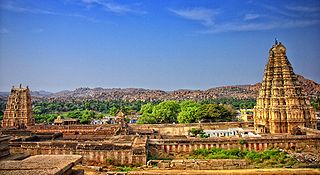
Hampi or Hampe, also referred to as the Group of Monuments at Hampi, is a UNESCO World Heritage Site located in Hampi (City), Ballari district now Vijayanagara district, east-central Karnataka, India. Hampi predates the Vijayanagara Empire; it is mentioned in the Ramayana and the Puranas of Hinduism as Pampa Devi Tirtha Kshetra. Hampi continues as a religious centre, with the Virupaksha Temple, an active Adi Shankara-linked monastery and various monuments belonging to the old city.

Vijayanagara was a city at the modern location of Hampi, in the Indian state of Karnataka. Vijayanagara was the capital city of the historic Vijayanagara Empire. Located on the banks of the Tungabhadra River, it spread over a large area and included sites in the Vijayanagara district, the Ballari district, and others around these districts. A part of Vijayanagara ruins known as the Group of Monuments at Hampi has been designated as a UNESCO World Heritage Site.
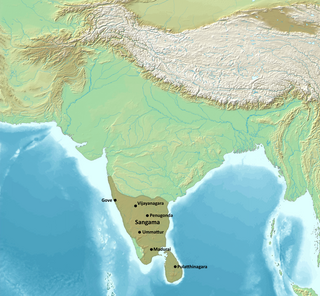
The Vijayanagara Empire was a medieval Indian empire that covered much of the region of Southern India, ruling the lands of the modern states of Karnataka, Andhra Pradesh, Tamil Nadu, Kerala, Goa, and some parts of Telangana and Maharashtra. It was established in 1336 by the brothers Harihara I and Bukka Raya I of the Sangama dynasty, members of a pastoralist cowherd community that claimed Yadava lineage. The empire rose to prominence as a culmination of attempts by the southern powers to ward off Turco-Persian Muslim invasions by the end of the 13th century. At its peak, it conquered almost all of Southern India's ruling dynasties and pushed the Turco-Persian sultans of the Deccan beyond the Tungabhadra-Krishna River doab region, in addition to annexing Gajapati Empire (Odisha) up to the Krishna River, thus becoming a notable power.

The Tungabhadra River is a river in India that starts and flows through the state of Karnataka during most of its course, Andhra Pradesh and ultimately joining the Krishna River near Murvakonda in Andhra Pradesh
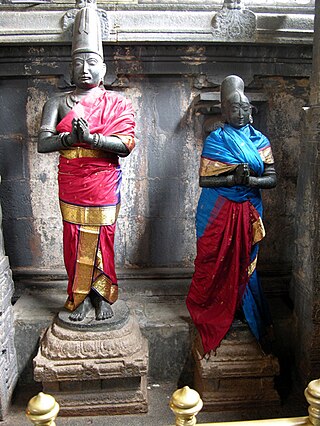
Achyuta Deva Raya was an Emperor of Vijayanagara who succeeded his older brother, the Emperor Krishna Deva Raya after the latter's death in 1529 CE.

Hospet or Hosapete is the largest and fastest-growing industrial city and district headquarters of the Vijayanagara district in the Indian state of Karnataka. Hosapete is known as "the steel city of Karnataka". It is located on the bank of the Tungabhadra River and is 13 km (8.1 mi) from Hampi (Vijayanagar). Hampi was once the capital of the Vijayanagara Empire. It has been designated a UNESCO World Heritage Site. Hospet is the connecting link between North and South Karnataka. It is 333 km (207 mi) from the state capital Bengaluru.
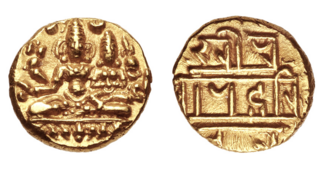
Harihara II was an Emperor of the Vijayanagara Empire from the Sangama Dynasty. He patronised the Kannada poet Madhura, a Jaina. An important work on the Vedas was completed during his time. He earned the titles Vaidikamarga Sthapanacharya and Vedamarga Pravartaka.

Deva Raya I was a king of the Vijayanagara Empire. After Harihara II died, there was a dispute between his sons over succession, in which Deva Raya I eventually emerged victor. He was a very capable ruler noted for his military exploits and his support to irrigation works in his kingdom. He modernized the Vijayanagara army by improving the cavalry, employed skilled archers of the Turkic clans and raised the fighting capacity of his bowmen and imported horses from Arabia and Persia.
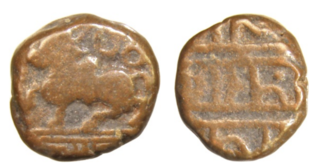
Deva Raya II was an emperor of the Vijayanagara Empire. The greatest of the Sangama dynasty rulers, he was an able administrator, warrior, and scholar. He authored well-known works in the Kannada language and in the Sanskrit language. He was patron to some of the most noted Kannada poets of the medieval period, including Chamarasa and Kumara Vyasa, the Sanskrit poet Gunda Dimdima, and the noted Telugu language poet Srinatha, whom the king honored with the title Kavisarvabhauma. He supported development in secular literature as well as the noted South Indian mathematician Parameshvara, from the Kerala school of astronomy and mathematics lived in his empire.

Virupaksha Raya II (1465–1485) was an Emperor of Vijayanagara from the Sangama dynasty.
Saluva Narasimha Deva Raya was an emperor of the Vijayanagara Empire from the Saluva Dynasty. A patron of the Madhwa saint Sripadaraya, he authored the Sanskrit work Rama Bhyudayam. He also patronised Kannada poet Kavi Linga.
The origin of the Vijayanagara Empire is a controversial topic in South Indian history, with regard to the linguistic affiliation of the founding dynasty, the Sangama family. The Vijayanagara Empire rose to power in southern India in the 14th century CE. Over the past decades historians have expressed differing opinions on whether the empire's founders, Harihara I and Bukka I, were of Kannada people or Telugu origin. There are various opinions about role of the Vidyaranya, the Hindu saint and guru of Harihara I and Bukka I in the founding of the Vijayanagara empire.

Virupaksha Temple is located in Hampi in the Vijayanagara district of Karnataka, India. It is part of the Group of Monuments at Hampi, designated as a UNESCO World Heritage Site. The temple is dedicated to Sri Virupaksha. The temple was built by Lakkan Dandesha, a nayaka (chieftain) under the ruler Deva Raya II, also known as Prauda Deva Raya of the Vijayanagara Empire.

Vijayanagara architecture of 1336–1565 CE was a notable building idiom that developed during the rule of the imperial Hindu Vijayanagara Empire. The empire ruled South India, from their regal capital at Vijayanagara, on the banks of the Tungabhadra River in modern Karnataka, India. The empire built temples, monuments, palaces and other structures across South India, with the largest concentration in its capital. The monuments in and around Hampi, in the Vijayanagara district, are listed as a UNESCO World Heritage Site.

The period of the Vijayanagara Empire is considered an age of prosperity in South India in the 14th century CE. Many travelogues written by visitors, ambassadors and authors of that time provide ample proof of a vibrant era. Agriculture was the main sustenance and the Tungabhadra was the life blood of the capital city.

Anegundi, previously called Kishkindha, is a village in Gangavathi, Koppal district, in the Indian state of Karnataka. It is older than Hampi, situated on the northern bank of the Tungabhadra River. Nimvapuram, a nearby village, has a mount of ash believed to be the cremated remains of the monkey king Vaali.

Hampi or Vijayanagara is a town in the Vijayanagara district in the Indian state of Karnataka. Located along the Tungabhadra River in the east and center part of the state, Hampi is near the city of Hosapete. It is famous for hosting the Hampi Group of Monuments, a UNESCO World Heritage Site.
Veera Ballala IV, also Veera Virupaksha Ballala was the last Hoysala king. He was the eldest son and successor of the powerful Hoysala emperor Veera Ballala III. He resided over a declining Hoysala kingdom, and was in constant war with the Turko-Persian Madurai Sultanate and an upcoming Vijayanagara Empire.

Matanga Hill is a rocky hill in the Matanga hill range, Hampi, Karnataka, southern India. The hill is supposedly a holy land from the Hindu Ramayana epic. The Matanga hill range served as a natural boundary of Hampi (Vijayanagara), which was the capital city of its namesake empire. Since the hills were a defense against attacks from outside lands, the Sangama brothers purposely put Vijayanagara there.



















